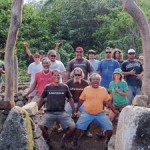Future Leaders Build A Traditional Hale
The dream of restoring a traditional Hawaiian hale on an ancient site in an effort to perpetuate the island’s culture and history has finally come true for Limahuli Garden and Preserve. Community members have been hard at work since last month gathering and assembling the natural elements needed for the hale’s construction located at the Ha’ena garden.
One of the most profound aspects of the project thus far is that it serves as an opportunity to bring people together.
“As we’re latching the hale together, symbolically we’re latching together our relationships,” says Kawika Winter, director of Limahuli Garden and Preserve.
The North Shore garden’s staff, consisting largely of native Hawaiians in their mid- to late-20s, is especially benefitting from the undertaking.
“We recognize they are the future leaders of our community,” says Winter. “But in order for them to really reach their potential as leaders, they need to have the knowledge, wisdom and experience. If we can provide them with these kinds of experiences, it will help them with their own development and infuse them with confidence so that they can speak with pride about the work.”
The hale is, in fact, one of three to be built by community members on National Tropical Botanical Garden grounds. A grant from the Office of Hawaiian Affairs has allowed the organization the financial ability to construct different traditional hales at Limahuli and McBryde gardens on Kaua’i, and Kahanu Garden on Maui. The houses are slated to be finished by March 31. Upon completion, each will serve primarily as educational tools for anyone who visits the gardens. With some 20,000 people arriving at Limahuli every year, including visitors from around the world, school groups and kama’aina, the ability for this quality of the Hawaiian culture to be shared is far-reaching.
Traditional hale construction has not occurred in Ha’ena for more than 100 years, so the home also will act as a symbol of honor for Hawai’i’s ancestors – not only honoring them, but perpetuating and reviving them.
“So it’s a really significant thing for the community,” says Winter.
In ancient times, Hawaiian hale sites were a complex of several homes, each serving different purposes. Hawaiian families were not nuclear and instead would consist of a large community. It’s estimated that there had been dozens of hale sites in Limahuli Valley.
The specific home to be constructed at Limahuli is called a hale noa, or a multiuse structure without kapu associated with it. Though it is unknown who originally lived in the structure currently being resurrected on the site, the inhabitants were likely responsible for the health of the water system.
“Whoever lived in this housing complex, undoubtedly, it was their kuleana to make sure the waters flowing into this agricultural complex were maintained,” says Winter.
The house is located at the apex of the largest agricultural complex in Ha’ena. “Almost literally the tip of the iceberg,” he says.
While construction of the hale embraces ancient methods and construction practices, such as using rocks from the valley and even some of those from the original foundation, the design is still a variation that must adapt to modern times.
For example, invasive plant species such as strawberry guava trees are being utilized as opposed to native species.
“We’re stewards of our valley – our forest is not that healthy now,” says Winter of why customary native species are not being used. A large aspect of the work at Limahuli is restoring the endangered Hawaiian forest. “But it’s not restored to the point yet where we can harvest (the necessary) amount of materials,” says Winter. “That doesn’t mean that our cultural traditions were put on hold until the forest is healthy again. We can substitute the species we use. Instead of using native hardwood, we use invasive hardwood.”
This practice, in turn, frees up space for more native species to be planted.
“And maybe one day,” he says, “our grandchildren will be able to use the trees we plant to perpetuate traditions like this.”
Visit ntbg.org for more information.
- Kawika Winter
- Volunteers work together to raise a Hawaiian hale at Limahuli Garden and Preserve. Coco Zickos photos
- Hale volunteers celebrate a good day’s work






